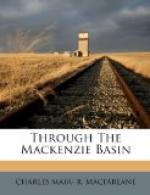The tar, whatever it may be otherwise, is a fuel, and burned in our camp-fires like coal. That this region is stored with a substance of great economic value is beyond all doubt, and, when the hour of development comes, it will, I believe, prove to be one of the wonders of Northern Canada. We were all deeply impressed by this scene of Nature’s chemistry, and realized what a vast storehouse of not only hidden but exposed resources we possess in this enormous country. What is unseen can only be conjectured; but what is seen would make any region famous. We now came once more to outcrops of limestone in regular layers, with disintegrated masses overlying them, or sandwiched between their solid courses. A lovely niche, at one point, was scooped out of the rock, over the coping of which poured a thin sheet of water, evidently impregnated with mineral, and staining the rock down which it poured with variegated tints of bronze, beautified by the morning sun.
With characteristic grandeur the bends of the river “shouldered” into each other, giving the expanses the appearance of lakelets; and after a succession of these we came to the first rapid, “The Mountain”—Watchikwe Powistic—so called from a peak at its head, which towered to a great height above the neighbouring banks. The rapid extends diagonally across the river in a low cascade, with a curve inward towards the left shore. It was decided to unload and make the portage, and a very ticklish one it was. The boats, of course, had to be hauled up stream by the trackers, and grasping their line I got safely over, and was thankful. How the trackers managed to hold on was to me a mystery; but the steep and slippery bank was mere child’s play to them. The right bank, from its break and downward, bears a very thick growth of alders, and here we found the wild onion, and a plant resembling spearmint.
In the evening we reached the next rapid, called the Cascades—Nepe Kabatekik—“Where the water falls,” and camping there, we had a symposium in our tent, which I could not enjoy, having headache and heartburn, a nasty combination. The 16th was the hottest day of the season—a hard one on the trackers, who now pulled along walls of solid limestone, perpendicular or stepped, or wrought into elaborate cornices, as if by the art of some giant stonecutter. At one place we came to a lovely little rideau, and on the opposite shore were two curious caves, scooped out of the rock, and supported by Egyptian-like columns wrought by the age-action of water.
Towards evening we reached the Crooked Rapid—Kahwakak o Powestik—and here the portage path followed on the summit of the limestone rampart, which the viscous gumbo-slides made almost impassable in rainy weather, and indeed very dangerous, forming, at the time we passed, pits of mud and broken masses of half-hard clay, along the very verge of the wall of rock, likely at any moment to give way and precipitate one into




